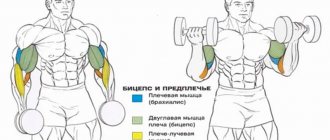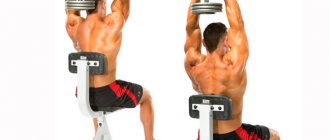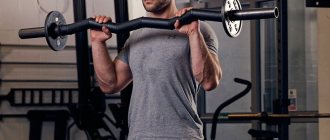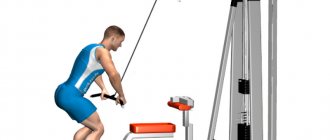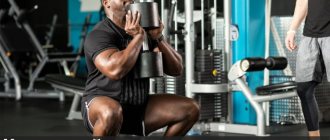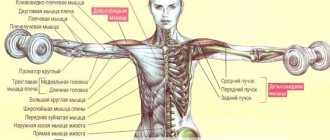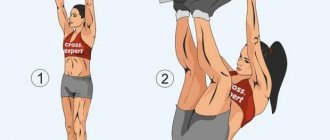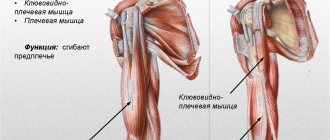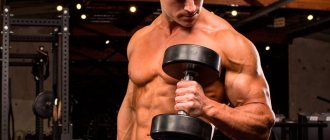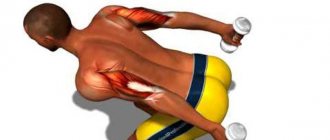This exercise perfectly outlines the biceps and gives it a sporty and sculpted shape. The essence of supination is the additional rotation of the hands when lifting dumbbells for biceps, which cannot be done with a barbell. This technique maximally engages all the fibers of the biceps, and with different variations of the exercise, you can additionally engage the anterior deltoid and upper part of the pectoral muscle.
Standing dumbbell curls with supination: technique
Two variations of the exercise are shown below.
- If you are gaining muscle mass , do 4x8-12;
- if you are working on relief and want to “dry” your muscles, you need to do 4 sets of 15–25 repetitions.
Option #1
- Standing, feet shoulder-width apart, arms with dumbbells hanging freely at your sides.
- Exhale: Raise the dumbbells by bending your elbows, keeping them close to your torso. When the angle at your elbows reaches 90 degrees, begin to turn your hands with the inside of your hands facing your shoulders. Make an effort through your biceps , do not swing your body or jerk the dumbbells up .
- Inhale: lower your arms more slowly in the reverse order, turning your hands to their original position.
Option No. 2
This version of supination is performed using the biceps and brachialis muscles.
- Standing, feet hip-width apart, dumbbells in hands. Turn your hands outward, performing supination immediately at the lowest point, and maintain this position.
- Exhale: bend your elbows, lifting the dumbbells to your shoulders, no longer performing a turn. The elbows remain in the same position.
- Inhale: Lower the dumbbells more slowly than when lifting. Do not unfold the brushes at the bottom .
Inclusion in the training program
Lifting dumbbells for biceps with supination is a fairly simple technical exercise. It is used to train biceps literally from the first sessions, both in home workouts and in the gym.
For beginners, this exercise still fades into the background. In their arm programs, biceps supination is used as an additional finishing factor after performing basic movements.
Lifting dumbbells with wrist rotation is the second or third exercise. The dumbbell weight used is light, and the repetition range is high - 12-15 times per approach.
For intermediate and advanced levels, this exercise can be both mass-building and grinding, aimed at detailing the muscle or “finishing” an already tired biceps.
During the period of mass training, trained athletes can do this exercise first in the complex. Then use medium-weight dumbbells in the range of 8-12 repetitions.
But it is usually placed in the middle of the program, using medium to light weights, with a rep range of 10-15 reps.
Often, bending with supination is done at the very end of the arm complex, in order to maximize blood supply to the biceps. In this case, lift light weight dumbbells in a multi-repetition mode (from 12-15 to 20 repetitions).
You can also do alternate dumbbell biceps lifts, separately with each hand. This way, the likelihood of cheating is reduced, and concentration on a specific party increases.
Seated dumbbell curls with supination
Another version of the exercise, which is performed while sitting, repeating variants 1 and 2 of supination from a standing position. The sitting position removes the load from the legs and fixes the position of the body. Especially for beginners who are not used to isolating the muscles from additional swinging, it is better to perform biceps curls while sitting .
- Sitting on a bench, arms with dumbbells hang freely. You can lean on the back of the bench at 90 degrees.
- Exhale: perform arm curls with supination (option No. 1 or 2).
- Inhale: slowly lower, returning your hands to their original position.
To increase mass, do 4x8-12, for relief , 4x15-25.
What muscles work in the exercise
Lifting dumbbells with supination is an isolating single-joint movement.
However, due to the rotation of the wrist, slightly more muscles are involved in the exercise than with classic curls.
Among them:
- The biceps brachii muscle is the main muscle targeted by the exercise.
- The brachialis (brachialis) and brachioradialis (brachioradialis) muscles are actively involved in the work when the palms are in a neutral position (at the range of motion from below to the middle, until the palms turn outward)
- The forearms are also loaded quite actively
- The anterior bundle of the deltoid muscle receives indirect static load
As soon as the elbows begin to move forward, the shoulders begin to work in a dynamic mode, and this is a serious technical error that should be avoided.
Lifting dumbbells for biceps alternately with supination
Alternating lifts allow the free arm to recover faster while the other one performs the contraction. This technique can help you perform the required number of repetitions when working with both hands at the same time; when there is no longer enough strength in the muscles, refine the exercise by bending alternately. Perform the exercise the required number of times and approaches depending on your goals.
Option #1
- While sitting, arms with dumbbells hang freely along the body. The elbows remain in place motionless.
- Exhale: bend one arm, bringing the elbow to a right angle, rotate the hand and contract the biceps, pausing at the top point .
- Inhale: in reverse order, lower your arm more slowly.
- Exhale: repeat immediately on the second arm and repeat in the desired mode (mass, relief) the same number of repetitions on each arm.
Option No. 2
In this version, in addition to the biceps and brachialis muscles, the anterior deltoids, the upper part of the pectoralis major muscle, and the brachioradialis are additionally included To maximize contraction of the biceps, lift your elbows in front of you, thanks to this the deltoids work.
- Sitting or standing, holding dumbbells in a pronated position (without turning).
- Exhale: Perform an arm curl with one arm, raising your elbow up in front of you. Rotate your hand and bring the dumbbell as far as possible to your shoulder, holding slightly.
- Inhale: slowly lower your arm to a free position.
- Repeat on the other side for the same number of repetitions.
Execution Sequence
1. Take the starting position, stand straight, back straight, feet shoulder-width apart 2. Take dumbbells in your hands with a grip closer to the thumb, palms facing inward 3. Press your elbows a little towards your body, lower your shoulders down and concentrate 4. Start bending the dumbbell slowly, having reached the middle of the amplitude, begin to rotate the forearm (supinate) inward 5. At the top point, do a peak contraction, but do not throw them very high, the tension is always in the biceps 6. Begin to lower the dumbbells, gradually returning the forearm to the starting position
Recommendations
When working with biceps, especially with the supination technique, do not chase too much weight . For high-quality muscle work, concentrated work is required; do not lift by jerking . Therefore, you will need a small load under which you can “purely” perform the exercise technique. Girls who want to make their arm muscles sculpted and toned are recommended to perform many repetitions in one approach - 20-25 times in 3 sets.
NEW IN THE MAGAZINE
From time to time, each of us is visited by a feeling of dissatisfaction with our appearance. As a rule, it is on Monday that we promise ourselves to start a new life, harmonious and full of different sensations. Word is word, but action is not always taken.
Do you know the constant feeling of fatigue, as well as the feeling that you no longer have the strength and never will again? The whole reason is that you are not resting completely. We will tell you how to get rid of the constant feeling of fatigue
It has long been known that diet affects health, appearance and well-being. Recently, scientists decided to find out whether there are foods that can cause stress.
Despite the emergence of many digital assets with unique characteristics, Bitcoin remains the most valuable and popular cryptocurrency in the world.
Modern medicine has come a long way in recent decades. Scientists have developed remedies for dangerous diseases and found the causes of their occurrence. However, the main question still remains open - prolongation of youth
As experiments have shown, in order to improve your health and significantly extend your life, you need to include regular beans in your daily diet.
MEN'S LIFE will give you some tips on how to best prepare for going to the beach to impress the girls
From time to time, each of us is visited by a feeling of dissatisfaction with our appearance. As a rule, it is on Monday that we promise ourselves to start a new life, harmonious and full of different sensations. Word is word, but action is not always taken.
We recommend reading: How to avoid gaining excess weight during the holidays
Do you know the constant feeling of fatigue, as well as the feeling that you no longer have the strength and never will again? The whole reason is that you are not resting completely. We will tell you how to get rid of the constant feeling of fatigue
It has long been known that diet affects health, appearance and well-being. Recently, scientists decided to find out whether there are foods that can cause stress.
Despite the emergence of many digital assets with unique characteristics, Bitcoin remains the most valuable and popular cryptocurrency in the world.
Modern medicine has come a long way in recent decades. Scientists have developed remedies for dangerous diseases and found the causes of their occurrence. However, the main question still remains open - prolongation of youth
As experiments have shown, in order to improve your health and significantly extend your life, you need to include regular beans in your daily diet.
MEN'S LIFE will give you some tips on how to best prepare for going to the beach to impress the girls
MEN'S LIFE MAGAZINE
All rights to materials located on the site are protected in accordance with the legislation on copyright and related rights. When using materials in full or in part, a direct active hyperlink to the Men's magazine MEN's LIFE is required.
MEN's LIFE is an online magazine for men, which is deservedly included in the TOP of the best men's magazines and portals. Every day, the most important topics on the most exciting topics for the male audience - a healthy lifestyle, sex and relationships, nutrition and diet rules, fitness and training, men's fashion and men's style, career and money, men's leisure and much more in our men's magazine.
The site administration is not responsible for a healthy lifestyle and the content of advertisements.
Shoulder instability
The shoulder joint is very mobile, but with little bone congruence, which predisposes it to hyperelasticity or instability. Instability of the shoulder joint can occur due to congenital hyperelasticity, trauma, or gradual loss of the ability to resist load of the ligamentous-capsular apparatus (19, 21). Repeated stretching of the ligamentous-capsular restraints increases the likelihood of permanent elongation (acquired ligament laxity) and injury (10, 21). If the ligaments or capsule become significantly weakened, surgery may be necessary to restore stability. Joint hyperelasticity refers to excessive mobility without pain, whereas joint instability is characterized by painful and uncontrollable excessive joint movements (21). With static instability or hyperelasticity of the ligamentous-capsular restraints of the shoulder joint, greater force is required from the rotator cuff muscles, the dynamic stabilizers of the humeral head (10). This type of dynamic compensation typically results in fatigue with rotator cuff tendonitis and pain. It is logical to assume that exercises with significant load on the ligamentous-capsular restraints should be avoided, especially if there is initial hyperelasticity or instability.
Anterior shoulder instability
The anterior shoulder capsule is the most common site of excessive motion and instability in the shoulder girdle (4). When resistance training people with anterior instability, the shoulder external rotation position combined with abduction and horizontal abduction should be avoided (Figure 1), as it places maximum load on the anterior joint capsule (6, 17 – 19). Examples of popular exercises that place the shoulder joint in a dangerous position (6): overhead rows, overhead presses, wide-grip bench presses, and pectoral flyes.
Figure 1. Shoulder external rotation combined with horizontal abduction.
To reduce stress on the anterior shoulder capsule, exercises traditionally performed behind the head or behind the head should be performed in the scapular plane, with the shoulder positioned ~300 anterior to the frontal plane of the body (21). The combination of shoulder external rotation, abduction, horizontal abduction, and excessive flexion while pulling a vertical pulley behind the head resulted in temporary arm paralysis from brachial plexus injury (23). The Chest Row is a replacement exercise for training the lats, rhomboids, and elbow flexors without compromising the anterior shoulder joint.
The standing press is often performed from behind the head, which puts the shoulder joints in a dangerous position. It is preferable to perform the barbell chest press from racks, dumbbells or in a machine, anterior to the frontal plane of the body. In our clinic, patients are advised to sit facing the back of the vertical press machine (Figure 2). This modification allows the shoulder joints to avoid dangerous positions when lifting weights.
Another exercise usually performed with a weight behind the head is the back squat. In the squat, the shoulder joints maintain a position of external rotation, abduction, and horizontal abduction. Clients with anterior shoulder instability should be advised to use an altered center of mass bar (13) or front squats. Using a bar with a modified center of mass or front squats moves the elbows anterior to the shoulder joints and significantly reduces the load on the anterior ligaments of the shoulder joint. To prevent injury from loss of weight control when performing front squats, we recommend using a Smith machine.
Figure 2. Vertical press anterior to the shoulder joints.
The wide-grip horizontal bench press should be modified with a barbell, dumbbells, or machine to avoid excessive horizontal abduction. As a result of the stress on the anterior shoulder ligaments from horizontal abduction combined with heavy loads, bilateral anterior shoulder dislocations have been observed during bench presses (1, 11). Excessive horizontal abduction during the bench press can be avoided by limiting the grip width to 1.5 shoulder width (7), placing a pillow or roller on the chest, or using range of motion limiters on a machine or Smith machine. Likewise, the grip width and abduction restrictions on the bench press machine protect the anterior shoulder joint limiters. Clients with instability need to be careful when pressing the barbell at an angle, as the arms are in a precarious position throughout the range of motion (5). Dumbbell presses at an angle reduce the risk of a dangerous position. With overhead presses, on the other hand, the arms are constantly in a safe position with shoulder flexion less than 900 and abduction up to 450 with minimal external rotation. This is a fairly safe option for exercising the chest muscles with a barbell or dumbbells.
Similar to the bench press, the distance between the arms of the push-up should also be limited to reduce horizontal abduction. An alternative way to perform push-ups using a standard push-up bench is shown in Figure 3.
Figure 3. Alternate push-up variation using a standard bench press.
The exercise can be performed from your knees or from a standard push-up position. In addition to reducing the load on the ligaments of the front part of the shoulder joint from a narrow position of the arms and movement at an angle, with this push-up technique, our clients noted less discomfort for the hands than with the standard push-up technique.
Another popular strength exercise for the front of the shoulder and chest are flyes. Excessive horizontal abduction can be avoided by performing the exercise while minimizing stretching of the anterior capsule. This can be achieved by instructing clients to start moving their elbows slightly anterior to their shoulder joints (in the plane of the scapula) and maintain the elbows through their full range of motion below the level of the shoulder joint.
People with instability and hyperelasticity of the anterior shoulder capsule should avoid stretching the pectoral muscles with horizontal extension and external rotation of the shoulder. Together with stretching the pectoral muscle during horizontal abduction with external rotation, the joint capsule is stretched. An alternative version of pectoral stretches is shown in Figure 4. These stretches primarily target the pectoralis minor muscle, but when performed correctly, the pectoralis major muscle is also moderately stretched.
Figure 4. Method of stretching the pectoral muscles for clients with hyperelasticity or instability of the anterior shoulder capsule: a) a relaxed shoulder is stretched against the corner of a wall using a rolled up towel; b) stretching begins with retraction of the scapula; c) greater stretch can be achieved by pulling the pectoral muscle towards the midline of the body.
Posterior shoulder instability
Just as stretching the anterior capsule can aggravate anterior instability, stretching the posterior capsule aggravates posterior instability. The posterior portion of the shoulder capsule is loaded by lifting the arms with flexed shoulders (close-grip presses or push-ups), by pulling the flexed shoulders forward (eccentric phase of pulling exercises), or across the chest (18, 21, 24). Obviously, it is necessary to completely eliminate stretching and strength exercises that load a shoulder with posterior instability. If posterior instability is present, cross-chest shoulder stretches should not be used. In addition, you need to modify the pulling exercises - do not reach for your arms during the eccentric phase of the pull. Clients should be encouraged to begin and end the pulling movement with their elbows slightly bent to reduce stretching of the posterior shoulder capsule. Also, if there is posterior instability, deadlifts and power cleans should be eliminated or modified. Both of these exercises stress the posterior capsule restraints as the arms are pulled forward while attempting to lift or lower the barbell to the floor. Deadlifts should be eliminated completely; but the chest lift can be replaced with a hanging lift, eliminating the pull from the floor.
People with posterior instability need to adjust their arm position when performing bench presses or push-ups. Unlike people with anterior instability who need close grips or arm support in bench presses and push-ups, people with posterior instability need to use a wide grip to direct forces from the hand into the glenoid fossa of the scapula.
Recommendations and tips: how to pump up your biceps with dumbbells
- It is the size of the biceps that affects how many times a week you can pump it. As mentioned, it does not require a lot of exercise, nor does it require frequent training. One lesson per week is enough, but if the biceps are a lagging group, then it is advisable to train it twice a week, but no more.
- To create a beautiful shape, it is important to train all the biceps, changing your grip and working weight, constantly adding load. The weight of the dumbbells should be suitable for work to “failure”, where the fibers are fatigued before 12 repetitions are reached. Therefore, the optimal number of repetitions is 8-12. Number of approaches: 3-4.
- To draw the biceps, you don’t need to focus on one muscle group; it is also important to develop the brachialis, which is worked out with the arm in a supinated and neutral position.
- Strive for body harmony, since developed biceps look comical compared to other untrained muscles. Therefore, train your triceps no less than your biceps. Pay attention to your legs and back, since in most basic exercises for large parts of the body, the biceps are the assistant.
